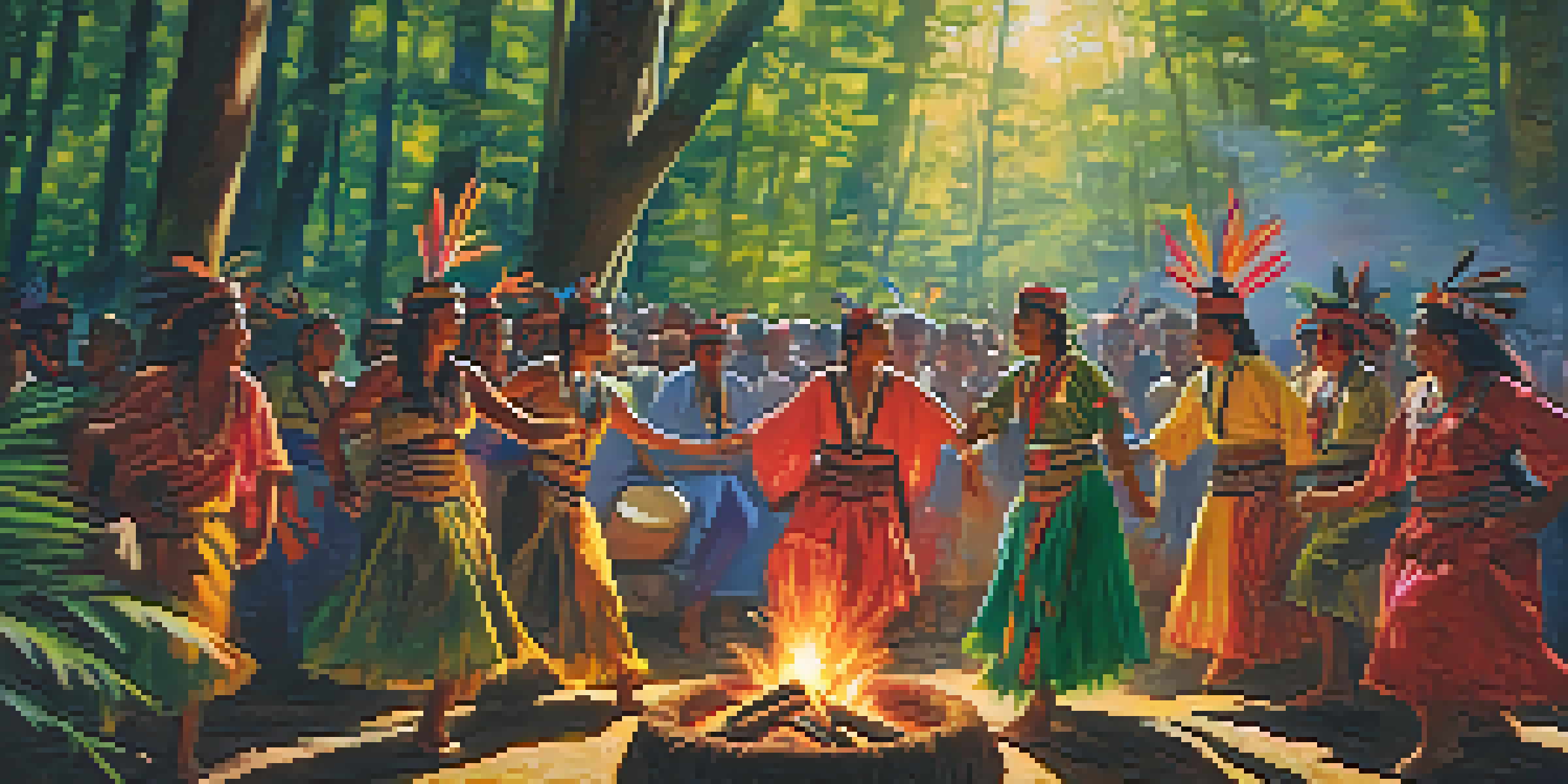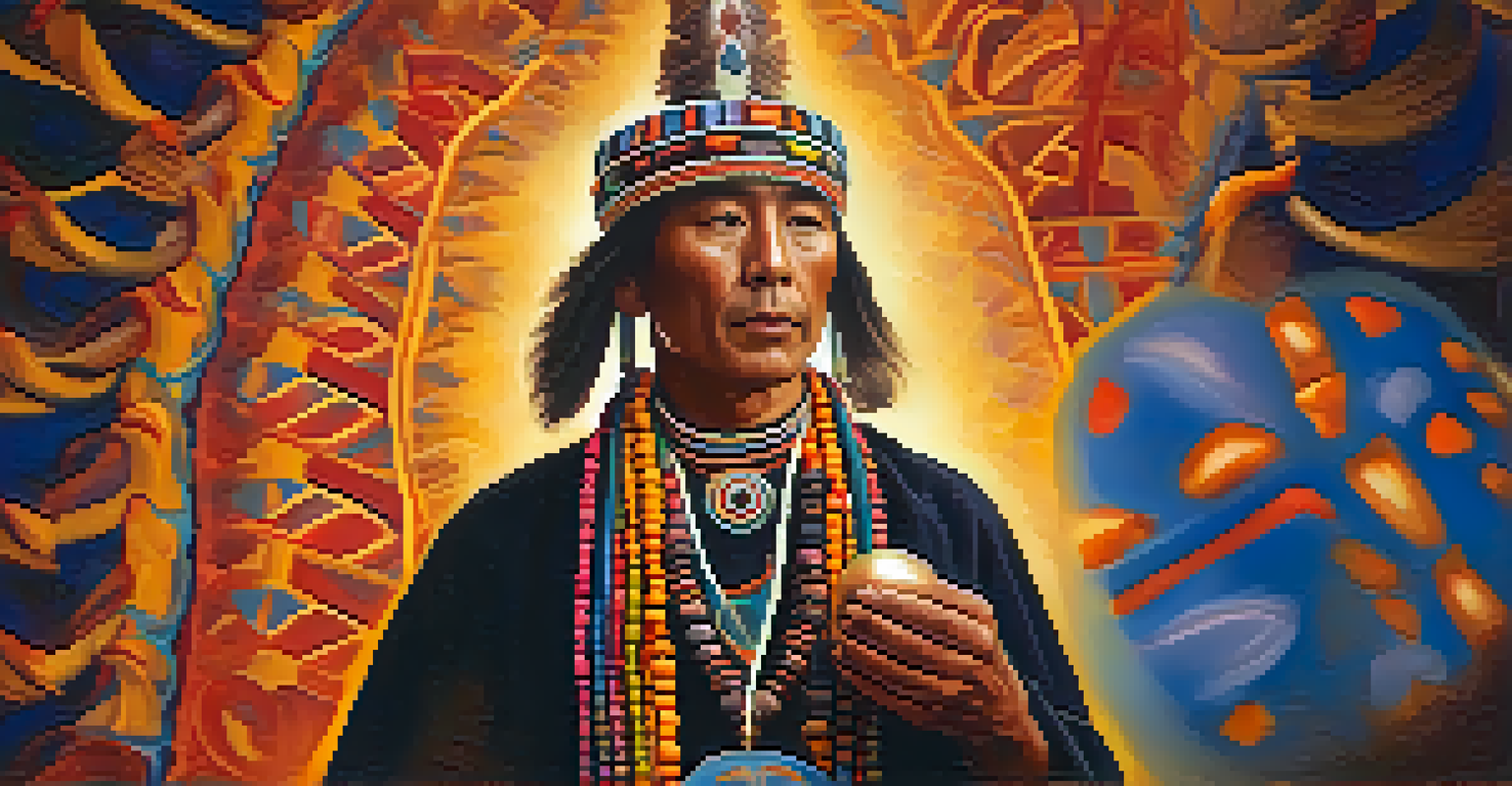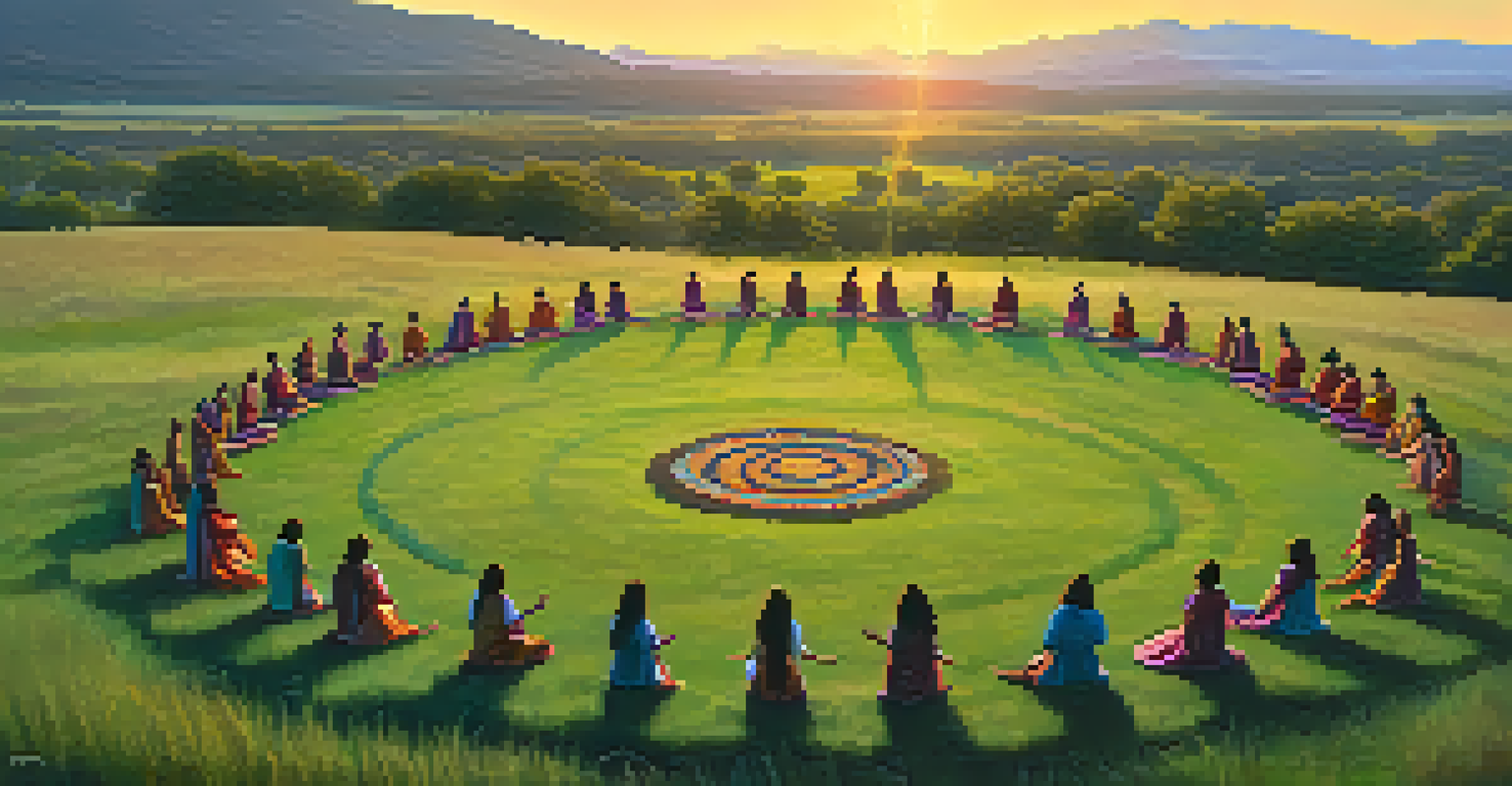Shamanic Dance: A Path to Spiritual Healing in Indigenous Cultures

Understanding Shamanic Dance in Indigenous Cultures
Shamanic dance is a vibrant expression of spirituality deeply rooted in various indigenous cultures. It serves as a bridge connecting the physical world with the spiritual realm, allowing participants to engage in a unique form of healing. Often characterized by rhythmic movements and ceremonial music, these dances invite individuals to experience profound emotional and spiritual release.
Dance is the hidden language of the soul.
In many cultures, shamanic dance is not merely a performance but a sacred ritual that channels energy and invokes spiritual guides. Participants often enter a trance state, facilitated by the repetitive beats of drums and chants, which can lead to transformative experiences. This connection between body, mind, and spirit is essential in fostering a sense of community and belonging.
The significance of shamanic dance varies among cultures but commonly emphasizes healing, celebration, and the honoring of ancestors. By participating in these dances, individuals can reconnect with their roots, find solace in shared experiences, and gain insight into their life journeys. Through this communal experience, shamanic dance becomes a powerful tool for personal and collective healing.
The Role of the Shaman in Dance Rituals
At the heart of shamanic dance is the shaman, a spiritual leader who facilitates the healing process. The shaman typically has undergone extensive training to connect with the spirit world and guide participants through their journeys. Their role is crucial, as they set the intention for the dance and create a safe space for individuals to explore their inner selves.

During the dance, the shaman may use various instruments, such as drums, rattles, or flutes, to enhance the experience. These instruments are believed to help invoke spirits and alter consciousness, making it easier for participants to access deeper emotional and spiritual layers. The shaman's guidance helps individuals navigate their experiences, ensuring they derive meaningful insights from the ritual.
Healing Through Shamanic Dance
Shamanic dance offers a powerful means of physical and emotional healing, allowing participants to release pent-up energy and unresolved feelings.
Moreover, the shaman often draws upon traditional stories and teachings to enrich the dance experience. By weaving together cultural narratives and spiritual wisdom, they create a holistic environment that fosters healing and personal growth. This connection to tradition not only enhances the dance but also strengthens the community's ties to their heritage.
Healing Through Movement: Physical and Emotional Benefits
Shamanic dance offers a multitude of physical and emotional benefits, making it an essential practice in many indigenous cultures. The act of moving rhythmically can help release pent-up energy, reduce stress, and improve overall well-being. As participants immerse themselves in the dance, they may feel a sense of liberation, both physically and emotionally.
The body says what words cannot.
On an emotional level, shamanic dance allows individuals to express feelings that may be difficult to articulate. The combination of music, movement, and communal support creates a safe space for vulnerability. Participants often report feelings of catharsis, as they confront and release unresolved emotions through the dance.
Additionally, studies have shown that dance can stimulate the release of endorphins, leading to improved mood and a sense of euphoria. This natural high can enhance the overall experience of spiritual healing, making shamanic dance not just a ritual but a powerful form of self-care. Ultimately, the physical and emotional benefits intertwine, fostering a holistic approach to healing.
Cultural Significance of Shamanic Dance Today
As society evolves, the importance of shamanic dance continues to resonate within contemporary spiritual practices. Many people are drawn to these ancient traditions in search of healing, connection, and authenticity. This resurgence reflects a broader interest in holistic wellness and a desire to reconnect with nature and ancestral roots.
Today, workshops and retreats dedicated to shamanic dance are becoming increasingly popular, attracting individuals from diverse backgrounds. Participants often seek to cultivate a deeper understanding of themselves and their place in the world, finding solace in the communal aspect of the dance. This modern adaptation of traditional practices allows for the preservation of cultural heritage while fostering inclusivity.
Cultural Relevance Today
The practice of shamanic dance is experiencing a resurgence as people seek deeper connections to themselves, others, and nature in contemporary spiritual contexts.
Moreover, shamanic dance is often integrated into therapeutic settings, highlighting its relevance beyond spiritual contexts. Mental health professionals and wellness practitioners recognize the value of movement in promoting emotional healing. This integration bridges the gap between ancient wisdom and contemporary therapeutic approaches, showcasing the timeless nature of shamanic dance.
Personal Stories: Transformative Experiences with Shamanic Dance
Many individuals have shared personal stories of transformation through shamanic dance, illustrating its profound impact on their lives. For some, the experience has been life-changing—providing clarity during difficult times or fostering a sense of belonging in a world that can often feel isolating. These narratives highlight the unique power of dance to facilitate healing and connection.
One participant shared how a shamanic dance helped her confront past traumas, allowing her to release feelings she had long buried. Through the rhythmic movements and supportive community, she felt a wave of emotional release that transformed her perspective on healing. Such stories affirm the notion that shamanic dance serves as a catalyst for personal growth.
These transformative experiences often extend beyond the dance floor, influencing individuals' daily lives and relationships. Participants may find themselves more in tune with their emotions, leading to healthier interactions and a greater sense of purpose. By sharing their journeys, these individuals inspire others to explore shamanic dance as a path to healing and self-discovery.
Connecting with Nature Through Shamanic Dance
A significant aspect of shamanic dance is its deep connection to nature, which plays a vital role in many indigenous cultures. Participants often dance outdoors, embracing the elements as they engage with the earth, sky, and spirit. This connection fosters a sense of unity with the natural world, reminding individuals of their place within it.
Nature's rhythms—such as the sound of rustling leaves or flowing water—often complement the dance, enhancing the overall experience. This immersion in nature can evoke feelings of peace and grounding, allowing participants to feel more connected to themselves and the universe. The natural setting serves as a backdrop for spiritual exploration and healing.
Role of the Shaman
The shaman plays a crucial role in guiding participants through the dance, facilitating transformative experiences that draw upon cultural narratives and spiritual wisdom.
Moreover, the act of dancing in nature can lead to a heightened awareness of one's surroundings. Participants may notice the beauty of the world around them, fostering gratitude and mindfulness. This connection not only enriches the dance experience but also encourages a deeper appreciation for the environment and its role in our spiritual journeys.
The Future of Shamanic Dance and Spiritual Healing
As interest in holistic practices continues to grow, the future of shamanic dance looks promising. Many practitioners and educators are dedicated to preserving these traditions while adapting them to contemporary contexts. This evolution allows for the inclusion of diverse perspectives and practices, enriching the experience for all participants.
The integration of technology and social media has also played a role in the resurgence of shamanic dance. Online workshops and communities provide access to teachings and experiences that may have once been limited to specific geographical areas. This accessibility fosters a global appreciation for shamanic traditions and their healing potential.

Ultimately, the future of shamanic dance lies in its ability to adapt and resonate with modern audiences while honoring its rich cultural heritage. As more individuals seek spiritual healing and connection, shamanic dance will continue to shine as a beacon of hope and transformation, reminding us of the power of community, movement, and spirit.